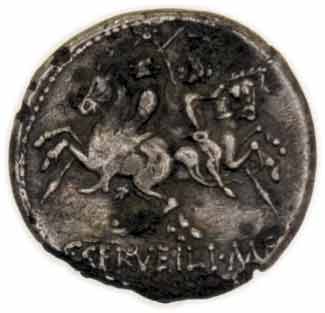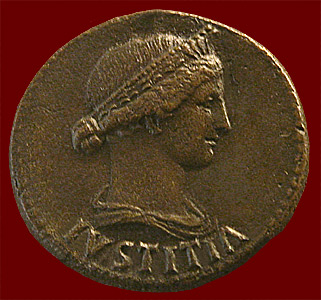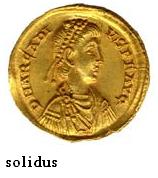Překrásný počteníčko, starý Řím mne zajímal již v dětství společně s Řeckem...
Roman coins and coinage
Categories: Minting - Numismatics
You might be interested in:
Catalogue of Roman Coin Finds
The first Roman coins began to be minted 2300 years ago, they were bronze and were struck with the Greek inscription ROMAION. Their name is AES SIGNATUM = marked metal. They were plate-shaped and weighed 1,600 g, measuring 90 x 170 mm. The casting process also produced the image. Often it was a bull or other animals. From the Latin term pecus - cattle, the name for money is derived - pecunia and from there the Czech word peníz, money, was also created.
The predecessor of aes signatum was the so-called AES RUDE = piece, raw copper. It is an unprocessed piece of copper weighing 2 g to 2.5 kg, used in Italian territory in the 1st millennium BC until the turn of the 4th and 3rd centuries BC as a medium of exchange

Coins called AES GRAVE = heavy metal, which were already round in shape. They were also made of copper. They are embossed on both sides. They are considered the beginning of Roman coinage. The basic unit was the as. It weighed one pound, i.e. 273 g, later 327 g. They were mainly used for internal trade.

After the consolidation of Roman power, gold and silver were also used for coinage. The first silver coins were called DIDRACHMES. They came into circulation after 290 BC, the coin was stamped with a she-wolf nursing the legendary founders of Rome, Romulus and Remus. Around 217 BC, the so-called staters appeared in Rome, weighing about 6.8 g. DENARIES were introduced into circulation between 213 and 211 BC. The denarius was made of silver and weighed about 4.5 g. The first denarius coin had the head of the goddess Roma on the obverse and 2 horsemen on horseback on the reverse.


The denarius is essentially a silver coin that began to be minted in the first half of the 3rd century BC in the Roman Republic. Its name is derived from the Latin denarius, dena. From the Roman denarius (nummus) grossus of 211 BC, the names of the later grossi were probably derived . The common money supply of wealthy citizens was around 1000-3000 sesterces. A family of three with a slave needed about 25 asses per day (i.e., about 570 denarii per year). The wealth of the richest men in the Roman Empire amounted to 400 million sesterces.
A summary of prices according to the finds from Pompeii:
bread = 1 ass
1 l of wine = 1 ass
prostitute = 8 ass
6 kg of wheat = 2 denarii
1 kg of pepper = 4 - 15 denariidenarii
2 slaves = 5,058 sesterces
funeral of a rich man = up to 25,000 denarii
holding games = 50,000 denarii
The value of early Roman coins was not very high compared to Greek coins. It is said that less than 10,000 crowns are enough to buy them. But the problem is the counterfeits. Both the aes signatum and the aes grave are forged very often and quite easily. The Roman denarius did not form the basic unit, but was equal to 16 aces, of which a good 12 counted in the basic unit of 1 ounce. Of the other Roman coins of multiples of an ace, the sestertius, which is equal to 4 aces, is probably the best known. In addition to the medieval denarius, there was also the obolus.

In the last years of the Roman Republic, just before the rise of the Empire, new gold coins called AUREUS began to be minted. It was 17-18 mm in diameter and weighed 5.46 g-7.28.
In 27 BC, Rome became an empire - a very well organized and prosperous state, issuing millions of different coins every year.
OVERVIEW OF OTHER COINS
SOLIDUS is a gold coin that replaced the gold aureus in 309 AD. It weighed 4.55 g.
QUINARIUS-ancient Roman silver coin =1/2 denarius = 5 ases.

DUPONDIUS is a brass coin whose price is equal to two aces. It weighs about 13,5 g.

Coin FOLLIS in honour of the abdication of Augustus Diocletian and Maximian, mint Trier, 1st workshop = PTR. - Reverse PROVIDENTIA DEORUM - QVIES AVGG = Providence of the Gods - the rest of the emperors (with personified Providentia and Quies). FOLLIS is a bronze coin weighing 10 g and 25-28 mm in diameter. The weight of this coin gradually decreased and the last coins weighed only 1.5 g.

TheTREMISSIS is a small gold coin weighing 1.5 g worth 1/3 of a solidus and is much less rare than a solidus in collector terms.

CENTENIONALIS - a copper coin with a diameter of 17-19 mm. There is also a 0.5 centenionalis, these two coins are often referred to in the literature as small bronzes or by the abbreviations AE 3 and AE 4.
Roman coins are also found in our territory, the finds are quite numerous, but they are rather single pieces. Bulk finds are rare and cover a very extensive period. In particular, coins from the 1st-2nd centuries and 3rd-4th centuries are found here. The coins came to our territory mainly thanks to trade and exploratory journeys of the Romans, which reached the area of our present state. Roman traders themselves introduced coins into circulation among the population living in our territory. The maintenance of military garrisons and relocated camps cannot be overlooked. However, many archaeologists and scholars believe that many of these were not direct payments and Roman  coins were therefore not in circulation. They only served in the Roman merchant - our market and back relationship. It must be remembered that in the Germanic environment only barter trade prevailed and there was no domestic coinage. Sometimes older silver denarii (no longer valid in Rome) or serrati (serrated coins) especially minted by Rome for trade with the Germanic people were used.
coins were therefore not in circulation. They only served in the Roman merchant - our market and back relationship. It must be remembered that in the Germanic environment only barter trade prevailed and there was no domestic coinage. Sometimes older silver denarii (no longer valid in Rome) or serrati (serrated coins) especially minted by Rome for trade with the Germanic people were used.
There are countless Roman coins, so I have tried to describe the most important ones. However, some sources differ, especially in the weight or dimensions of the individual coins.
Do you also want to find a historical coin? Take a look at our metal detectors.
The article is included in categories:
Post
I na řecké mincovnictví přijde řada...
Moc pěkný kousky!!!
To taky můžu, to je paráda.
Moc hezky a zajimavy clanek,velmi poucny pro nas koleckare...
V létě jsem se motal v Itálii v Bolzanu, byl jsem se mrknout do muzea na Otziho a byla tam taky zbírka Římských mincí, no moc hezky se na ně koukalo, hlavně na ty zlatý, ty se tak lákavě lesknou.....
dik za clanek moc pekne a prehledne ..:)
No co dodat fááááááách dobrý,hlavně ten převodník co za kolik.
Knedlajz
Výborně zpracovaný článek a celý server.
ja som ešte nový,ale zásluhou bobanxa už sem tady!Ináč je ten článok super tak ako aj celá vaša stránka.som z madarskej národnosti,a som rád že som našiel aj článok o Attilovi...
Moc pěkný článek. Chtěl bych se zeptat. S mincemi jsem začal nedávno a celkem mě zajímá Řím a Antika. Mohl byste mi někdo dát odkazy na nějakou literaturu o mincích z této doby? Ať na netu nebo knižní.
Děkuju
Super článek. Díky


































